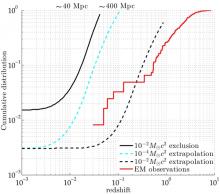
Abstract
We present the results of a search for gravitational waves associated with 154 gamma-ray bursts (GRBs) that were detected by satellite-based gamma-ray experiments in 2009-2010, during the sixth LIGO science run and the second and third Virgo science runs. We perform two distinct searches: a modeled search for coalescences of either two neutron stars or a neutron star and black hole, and a search for generic, unmodeled gravitational-wave bursts. We find no evidence for gravitational-wave counterparts, either with any individual GRB in this sample or with the population as a whole. For all GRBs we place lower bounds on the distance to the progenitor, under the optimistic assumption of a gravitational-wave emission energy of 10–2M ☉c 2 at 150 Hz, with a median limit of 17 Mpc. For short-hard GRBs we place exclusion distances on binary neutron star and neutron-star-black-hole progenitors, using astrophysically motivated priors on the source parameters, with median values of 16 Mpc and 28 Mpc, respectively. These distance limits, while significantly larger than for a search that is not aided by GRB satellite observations, are not large enough to expect a coincidence with a GRB. However, projecting these exclusions to the sensitivities of Advanced LIGO and Virgo, which should begin operation in 2015, we find that the detection of gravitational waves associated with GRBs will become quite possible.